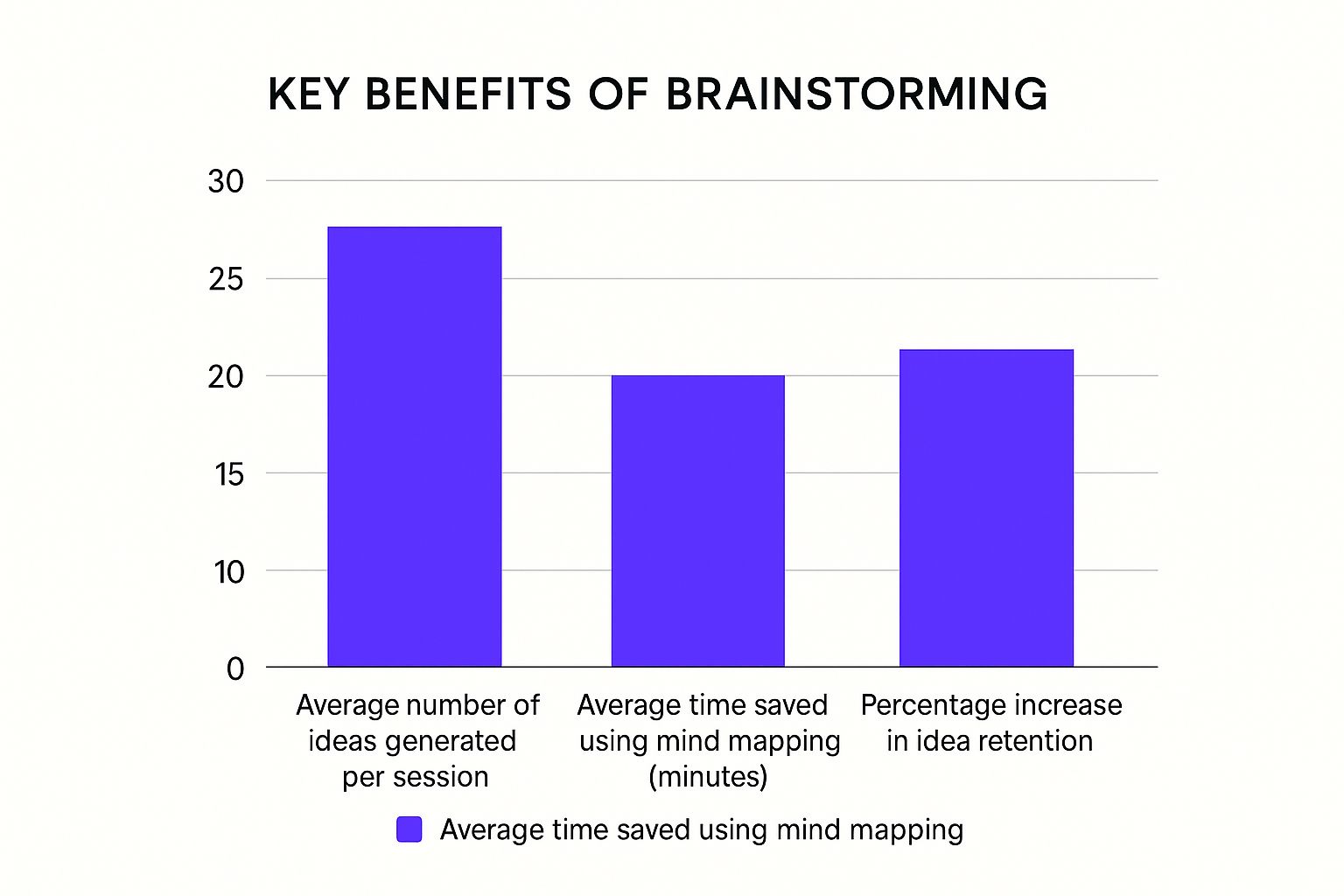The Evolution of Brainstorming and Mind Mapping

From simple cave drawings to the digital tools we use today, capturing and connecting ideas has a long and interesting history. This journey has given us two powerful techniques: brainstorming and mind mapping. While they seem modern, their origins go back centuries. Let's explore this fascinating evolution and see how these methods became essential for generating ideas and solving problems.
The Genesis of Brainstorming
Brainstorming, as we know it, began with Alex Osborn in the 1950s. He created a structured approach to generating ideas, focusing on quantity over quality and postponing judgment. This was a big change from traditional problem-solving.
This new technique quickly became popular and a key part of creative problem-solving across many industries. By 2001, over 70% of businesspeople reported using brainstorming. It's still widely used today, especially in research and development at companies like Google and Amazon. Want to delve deeper? Learn more about the history of brainstorming.
The Rise of Mind Mapping
Visual thinking methods were also developing alongside brainstorming. Early versions of mind mapping existed in ancient civilizations, using visuals to record and share information. Humans have always visualized their thoughts, and this formed the basis for Tony Buzan's formal mind mapping technique in the 1970s.
Buzan studied the notes of historical figures like DaVinci and Einstein. He noticed patterns in their visual thinking and developed these into a practical method.
From Analog to Digital
At first, brainstorming and mind mapping were mainly done on paper. Teams used whiteboards, sticky notes, and markers. Individuals drew their ideas, creating complex webs of interconnected thoughts.
The digital age changed everything. Software now allows remote teams to brainstorm and mind map together, no matter where they are. This makes these techniques more accessible and efficient, opening up new possibilities for idea generation and collaboration. Digital mind maps are easy to share, edit, and save, making them very useful in project management, education, and other fields. New tools and techniques continue to emerge, making brainstorming and mind mapping even more powerful.
The Science Behind Breakthrough Idea Generation

The infographic above illustrates the key benefits of brainstorming and mind mapping. It compares the average number of ideas generated, the time saved with mind mapping, and the percentage increase in idea retention. These techniques offer significant advantages for generating and retaining ideas, as well as improving overall efficiency. This stems from how these methods utilize our natural cognitive functions. Brainstorming and mind mapping work with the way our brains naturally connect ideas.
Cognitive Psychology and Idea Generation
What's happening in your brain during a productive brainstorming session? Exposure to a variety of ideas creates new neural pathways. This means group brainstorming can spark more creative ideas than solo work. However, these sessions require careful structuring to avoid common problems.
Judgment and criticism, for example, can hinder the creative process. A core principle of effective brainstorming is fostering a psychologically safe environment. This is where participants feel comfortable sharing any idea, no matter how unconventional. For further exploration into sparking creativity, check out this resource: spark creativity. This approach encourages a free flow of thoughts, allowing participants to expand on each other's suggestions.
Group Dynamics and Facilitation
Research shows smaller groups, ideally between five and seven people, are most effective for brainstorming. Larger groups can lead to production blocking, limiting individual opportunities to contribute. Skilled facilitators can help manage these dynamics, ensuring every voice is heard. For more in-depth techniques, this resource may be helpful: How to master brainstorming and mind mapping with our top 10 ideation techniques.
The physical environment also plays a role. A comfortable space with natural light and visual inspiration can boost idea generation. Such a setting helps participants relax and open their minds to new possibilities, ultimately leading to a more productive session. It fosters divergent thinking, the exploration of a wide range of ideas, which is essential for innovation.
Balancing Divergent and Convergent Thinking
Divergent thinking is crucial during brainstorming, but effective idea generation also requires convergent thinking. This is the process of evaluating and refining ideas to choose the best solutions. Mind mapping provides a visual structure for organizing brainstormed ideas. This allows participants to see how ideas connect, find patterns, and prioritize next steps.
To compare these different brainstorming approaches, take a look at the table below:
Group vs. Individual Brainstorming Comparison
A comparison of the advantages and limitations of group and individual brainstorming approaches
| Aspect | Group Brainstorming | Individual Brainstorming | Hybrid Approach |
|---|---|---|---|
| Idea Generation | High potential for diverse ideas, can spark unexpected connections | Can be focused and efficient, allows for deep individual exploration | Combines individual ideation with group refinement for a balanced approach |
| Efficiency | Can be time-consuming if not managed well, potential for production blocking | Highly efficient for focused ideation, no scheduling conflicts | Balances individual focus with collaborative synergy |
| Psychological Safety | Requires careful facilitation to ensure all participants feel comfortable sharing | Naturally safe space for uninhibited idea generation | Fosters individual exploration before group sharing for increased comfort |
| Resources | Requires a dedicated time and space for the group to meet | Minimal resource requirements | Requires resources for both individual and group phases |
| Actionability | Can be challenging to synthesize a large volume of ideas into actionable steps | Easier to prioritize and develop individual ideas | Allows for a structured process of individual brainstorming and group refinement for increased actionability |
This table summarizes the key differences between group, individual, and hybrid brainstorming approaches. By considering these factors, you can choose the best method for your needs and maximize your idea generation potential. Mind maps help bridge the gap between a flurry of ideas and a concrete plan of action.
Visual Thinking: Unleashing Your Mind's Full Potential

Visual thinking, and mind mapping in particular, can significantly boost your creative potential. Unlike linear notes, which can feel a bit clunky and don't always align with how our brains naturally work, mind maps actually mirror the way our neural networks make connections. This activates both the analytical and creative parts of your brain at the same time. It makes idea generation feel much more natural and less forced. This section explores the core principles of visual thinking and how mind mapping can help you unlock your creative potential.
Why Visual Thinking Matters
Visual thinking takes advantage of our brain's natural preference for images and patterns. The old saying, "a picture is worth a thousand words" really holds true here. Visuals communicate information much more efficiently, and we tend to remember them better than text alone. For example, a quick sketch can often convey a complex idea much more effectively than a long, drawn-out explanation. This principle is at the heart of why mind mapping is so effective.
Mind maps also use colors, images, and spatial relationships strategically—and not just to make them look nice. These visual elements actually change how we process and retain complex information. Colors can help categorize related concepts. Images can act as memory anchors. And the spatial arrangement of the map can clarify hierarchies and connections, making it easier to see the big picture while still remembering the important details. This layered approach to information processing makes mind mapping a powerful tool for both brainstorming and getting a handle on complex topics.
Mind Mapping: A Powerful Visual Thinking Tool
At its core, mind mapping is all about connecting ideas visually. This practice actually has a long history, going back thousands of years. People have been using images and diagrams to record information and communicate ideas long before computers even existed. The modern idea of mind mapping as we know it today was popularized by Tony Buzan in the 1970s. Buzan noticed similarities in the notes of creative geniuses like Da Vinci and Einstein, who both used visual methods. He then took those observations and turned them into the structured mind mapping technique that we use today. Want to learn more? Discover more insights about the evolution of mind mapping.
Mind mapping helps you see hidden connections between ideas that might seem completely unrelated at first. By visualizing these relationships, you can identify new opportunities and solutions that you might have missed otherwise. This is what makes brainstorming and mind mapping such effective tools for innovation and problem-solving. Plus, mind maps create a clear framework that makes even the most complex information instantly accessible.
Practical Applications of Mind Mapping
Mind mapping can be used in so many different ways and across various fields. From brainstorming new product ideas to breaking down complicated scientific research, mind maps make complex information much easier to digest. They help you see the big picture while keeping track of all the details. Here are just a few examples:
- Project Planning: Visualize tasks, dependencies, and deadlines.
- Problem Solving: Explore the root causes of problems, brainstorm solutions, and understand the impact of those solutions.
- Learning and Studying: Organize information in a hierarchical way, making it easier to absorb and remember.
- Meeting Management: Capture important discussion points and action items in a visual format.
This versatility is why leading organizations and creative professionals are increasingly turning to mind mapping to unlock their teams' cognitive potential. It’s more than just a note-taking method. It’s a powerful tool for thinking visually, enabling you to generate new ideas, solve tough problems, and understand complex information in a way that’s both effective and engaging. It empowers teams to come up with more innovative ideas and develop stronger solutions. And the best part? You can apply this technique to pretty much any field, from project management to education, improving both individual and collaborative efforts.
Facilitating Brainstorming Sessions That Actually Work
Turning unproductive meetings into dynamic brainstorming sessions takes effective facilitation. This means guiding the session through distinct phases, from careful planning to actionable results. Let's explore the key elements of successful brainstorming.
Setting the Stage for Success
Productive brainstorming starts with preparation. This involves defining the objective, choosing the right participants, and selecting a suitable format. For example, a session about new product ideas will have different needs than one focused on solving a customer service issue.
Creating a psychologically safe environment is critical. This encourages open contribution without fear of judgment, leading to more diverse ideas and reducing the risk of groupthink, where team members hesitate to challenge popular opinions.
Managing Group Dynamics
Even in a safe space, managing group dynamics is essential. Dominating personalities can sometimes overshadow quieter voices. Facilitators need to ensure everyone gets a chance to contribute.
Techniques like round-robin brainstorming, where each person shares an idea in turn, can promote equal participation. Facilitators must also watch for idea fixation, where the group gets stuck on initial ideas. Prompts or a shift in focus can unlock fresh perspectives. For online sessions, check out our guide on How to master virtual brainstorming.
Choosing the Right Brainstorming Format
Different brainstorming methods work better in different situations. Brainwriting, where participants individually write down ideas before sharing, can generate a large number of ideas quickly. Reverse thinking, where the group brainstorms ways to cause the problem, can uncover surprising solutions.
Understanding the strengths and weaknesses of each format helps facilitators pick the best approach for their specific needs, leading to more relevant and innovative outcomes.
From Ideas to Action
Brainstorming often falls short due to a lack of follow-up. Ideas generated during the session can get lost, making the process ineffective. Capturing and organizing these ideas is essential. Mind mapping offers a visual way to structure ideas and identify connections.
Sessions should also end with a clear action plan. This involves prioritizing ideas, assigning responsibilities, and setting deadlines. This structured approach ensures brainstorming results in tangible action, not just forgotten notes.
Brainstorming Techniques and Their Applications
To help you select the best method for your next session, the following table offers an overview of different brainstorming techniques and their ideal applications.
To help you choose the right technique, let's look at several common brainstorming methods.
| Technique | Description | Best Used For | Limitations |
|---|---|---|---|
| Round-Robin | Participants take turns sharing ideas. | Generating a wide range of initial ideas and encouraging equal participation. | Can be slow and may limit spontaneous ideas. |
| Brainwriting | Individuals write down their ideas before sharing with the group. | Overcoming groupthink and encouraging diverse thinking. | Requires more preparation and may reduce immediate interaction. |
| Reverse Thinking | The group brainstorms ways to cause the problem. | Tackling complex problems and breaking through mental blocks. | Can be difficult to shift from reverse thinking back to solutions. |
| Starbursting | Asking "who, what, when, where, why, and how" questions about a central idea. | Expanding initial concepts and exploring different aspects of a problem. | Can become too structured if too many questions are generated. |
This table summarizes several brainstorming techniques, helping you select the best one for your next session. By applying these techniques, you can transform brainstorming from a random activity into a powerful tool for generating innovative solutions. The goal is not just to come up with ideas, but to create actionable insights that drive progress and achieve objectives.
Crafting Mind Maps That Drive Clarity and Insight

Mind maps are more than just simple spider diagrams. They can be powerful tools for enhancing your thinking process. This involves understanding the key principles that separate truly effective mind maps from less useful ones. These principles work with the way our brains naturally process information, making mind maps ideal for brainstorming and idea generation.
The Power of the Central Image
The central image anchors your entire mind map. This is important not just for aesthetics, but for building a strong visual foundation for your brainstorming session. A compelling central image immediately sets the tone and focus for the topic. For example, if you're brainstorming marketing strategies for a new product, the central image could be the product itself or its target customer.
Main branches radiate outwards from the central image. Each branch represents a key theme or concept. These main branches should be thicker than the sub-branches that stem from them, creating a visual hierarchy. This structure mirrors how our brains organize information, making the mind map easier to understand and use. When brainstorming, reviewing examples can be helpful, like how to brainstorm new social media ideas.
Using Color and Keywords Strategically
Color plays a vital role in mind mapping. It helps organize information effectively. Assigning different colors to different categories or themes allows you to quickly identify relationships and patterns. For example, blue might represent financial aspects, green for environmental factors, and red for potential risks.
Each branch should include a concise keyword or short phrase summarizing the main idea. This maintains clarity and prevents the mind map from becoming cluttered. These keywords act as memory triggers, making it easier to recall information later. For inspiration, you might be interested in exploring different mind map examples.
Maintaining Clarity in Complex Topics
One of the biggest challenges in mind mapping is managing complex topics. As ideas and connections grow, the mind map can become overwhelming. To prevent this, establish clear boundaries and define the right level of detail.
Treat your mind map as a dynamic tool. You can start with a high-level overview and then add details in specific areas as needed. This helps manage complexity, allowing you to explore different layers of information without losing sight of the bigger picture. This approach also works well for moving between paper and digital formats. Begin brainstorming on paper to capture the initial flow of ideas and then transfer key elements to a digital mind map for further development and collaboration.
From Capture to Insight
Effective mind maps do more than just capture information; they transform it. They give you a visual framework for understanding relationships between ideas and finding breakthrough solutions. By arranging ideas spatially and visually connecting them, you can discover hidden patterns and connections that might be missed in linear notes. This can lead to new insights and innovative solutions.
Consider project planning. A mind map can visually represent tasks, dependencies, and timelines. This lets you see the entire project at a glance, identifying potential bottlenecks or areas needing attention. Similarly, mind maps can be used to analyze complex problems, exploring root causes and brainstorming solutions in a structured, visual way. Whether organizing research, planning projects, or solving problems, mind maps are a powerful tool for turning information into actionable insights. This enhances your understanding of connections between ideas, leading to better problem-solving and decision-making.
The Synergy Effect: Combining Methods for Maximum Impact
Brainstorming and mind mapping are often used independently. However, their real strength lies in their combined use. This integrated approach creates a powerful synergy, transforming scattered thoughts into actionable plans. This section explores how these two techniques complement each other, maximizing their impact on idea generation and problem-solving.
From Divergent Thinking to Convergent Action
Brainstorming excels at divergent thinking. This means generating a wide array of ideas without judgment. It’s crucial for exploring possibilities and breaking free from conventional solutions. But a flurry of ideas alone won’t solve problems.
This is where mind mapping comes in. It provides the framework for organizing the output of a brainstorming session, transitioning from divergent thinking to convergent thinking. Mind maps turn a chaotic collection of thoughts into a structured, visual representation.
Structuring Brainstorming With Mind Maps
Many teams use mind maps during brainstorming sessions. The central topic acts as the anchor, with main branches representing key themes or categories. As ideas emerge, they are added to the relevant branches, creating a visual record of the discussion.
This approach provides just enough structure to guide the brainstorming process without stifling creativity. Participants see how ideas relate to each other, sparking new connections and keeping the discussion focused. It’s like building a roadmap while exploring new territory.
Turning Ideas into Actionable Plans
After brainstorming, the mind map becomes a powerful tool for analysis and planning. It helps teams identify key themes, prioritize ideas, and develop action steps. The visual layout makes it easy to see which ideas have the most potential and how they fit into the overall plan.
For example, a product development team might use a mind map to organize feedback from a brainstorming session on new features. They can categorize ideas by user needs, technical feasibility, and business impact. This visualization helps prioritize which features to develop first and how they contribute to the product roadmap.
Practical Workflows for Combining Brainstorming and Mind Mapping
Several workflows combine brainstorming and mind mapping effectively. One approach is to start with individual brainstorming using brainwriting. Participants write their ideas on sticky notes or in a digital tool. These ideas are then transferred to a shared mind map during a group session, fostering discussion and building on each other's contributions.
Another method is to start with a central question or problem statement at the center of the mind map. The team then brainstorms ideas directly onto the map, using different colors or symbols for categories. This real-time visualization keeps everyone focused and facilitates a more productive discussion.
Real-World Examples of Synergy in Action
The combined power of brainstorming and mind mapping is evident across diverse fields. In strategic planning, it helps organizations define goals, analyze market trends, and develop innovative strategies. In product development, these methods generate new product ideas, identify customer needs, and prioritize features.
Whether tackling complex business challenges or personal creative projects, combining brainstorming and mind mapping offers a powerful framework for turning inspiration into tangible results. This method ensures creative insights are captured, organized, and transformed into actionable plans that drive real outcomes.
Ready to supercharge your team's brainstorming sessions? Discover Bulby, the brainstorming tool designed for remote teams.

